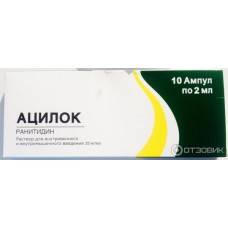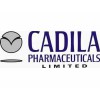Expiration date: 03/2026
Dosage form:
solution for intravenous and intramuscular injection, tablets, tablets coated tablets effervescent
Pharmacological action:
Blocker of H2-histamine receptors of the second generation. The mechanism of action related to blockade of H2-histamine receptors in the membranes of parietal cells of the gastric mucosa. Suppresses day and night secretion of HCl, as well as basal and stimulated, reduces the volume of gastric juice, caused by stretching of the stomach with food load, action of hormones and biogenic stimulators (gastrin, histamine, acetylcholine, pentagastrin, caffeine). Reduces the amount of HCl in gastric juice almost without suppressing "liver" enzymes associated with cytochrome P450, does not affect the concentration of gastrin in plasma, production of mucus. Reduces the activity of pepsin. Does not affect the concentration of Ca2+ in the blood serum. After oral administration in therapeutic doses does not affect the concentration of prolactin (possibly undergoing a slight increase of prolactin concentration in serum after I/V administration of ranitidine at a dose of 100 mg or more). Has no effect on the secretion of pituitary hormones: gonadotropin, TSH and GH. Does not affect the concentration of cortisol, aldosterone, androgens or estrogen, sperm motility, number and structure of sperm, and it has no antiandrogenic action. Can weaken the release of vasopressin. Enhances the protective mechanisms of the gastric mucosa and promotes healing of damage associated with exposure to HCl (incl. cessation of gastrointestinal bleeding and scarring of stress ulcers) by increasing the formation of gastric mucus, its content of glycoproteins, stimulating the secretion of bicarbonate by the mucous membrane of the stomach, endogenous synthesis of Pg in it and speed of regeneration. At a dose of 150 mg inhibits the secretion of gastric juice for 8-12 hours Inhibits microsomal enzymes (less than cimetidine).
Indications:
Treatment and prevention - peptic ulcer and 12 duodenal ulcer, NSAID-gastropathy, heartburn (associated with hyperchlorhydria), hypersecretion of gastric juice, symptomatic ulcers, gastrointestinal stress ulcers, erosive ezofagit, reflux-ezofagit, syndrome zollingerellison, systemic mastocytosis, polyendocrine adenomatosis, dyspepsia, epigastric or retrosternal characterized by pain associated with food intake or sleep-disturbing, but not due to the above conditions, treatment of bleeding from the upper gastrointestinal tract, prevention of recurrence of gastric bleeding in the postoperative period, prevention of gastric aspiration in patients undergoing surgery under General anesthesia (Mendelson's syndrome), aspiration pneumonitis (prevention), rheumatoid arthritis (as adjuvant therapy).
Contraindications:
Hypersensitivity, lactation.C caution. Renal and/or hepatic failure, liver cirrhosis with portosystemic encephalopathy (in history), acute porphyria (including in history), children's age (till 12 years), pregnancy.
Side effects:
From pisciarelli system: nausea, dry mouth, constipation, vomiting, diarrhea, abdominal pain, increased activity "liver" transaminases, rarely hepatocellular, cholestatic, or mixed hepatitis, acute pancreatitis. Organs of hematopoiesis: leukopenia, thrombocytopenia, agranulocytosis, pancytopenia, Hypo - and aplasia of the bone marrow, immune hemolytic anemia. By SSS: reducing AD, aetiology, arrhythmia, AV blockade, asystole (when administered parenterally). From the nervous system: headache, dizziness, fatigue, drowsiness, rarely - confusion, tinnitus, irritability, hallucinations (mainly in elderly patients and severely ill), involuntary movements. From the senses: blurred vision, paresis of accommodation. From the musculoskeletal: arthralgia, myalgia. From the endocrine system: hyperprolactinemia, gynecomastia, amenorrhea, reduced potency and/or libido. Allergic reactions: hives, skin rash, angioedema, anaphylactic shock, bronchoconstriction, multiforme exudative erythema. Other: alopecia, gipercreatininemia, increased activity of glutamiltranspeptidaza, acute porphyria.
Overdose:
Symptoms: seizures, bradycardia, ventricular arrhythmias. Treatment: symptomatic. With the development of convulsions - diazepam/with bradycardia - atropine, ventricular arrhythmias - lidocaine. Hemodialysis is effective.
Method of application and dose:
Parenteral (in/in, in/m) inside. In/in slowly (within 5 min) of 50 mg, in a dilution of 0.9% NaCl or 5% dextrose solution 20 ml, if necessary, carry out repeated administration every 6-8 hours in/In the drip, with a speed of 25 mg/h for 2 hours, if necessary - re-introduction after 6-8 h/m - 50 mg 3-4 times a day. For the prevention of bleeding from the upper gastrointestinal tract in patients with stressful ulcers preferably in/in the slow introduction in a dose of 50 mg with subsequent continuous I/V infusion of 0.125-0.25 mg/kg/h. The introduction is carried out until, until the patient can not make their own food. Patients with persistent risk of bleeding in the future, administered orally, 150 mg 2 times a day (as soon as the nutrition of patients through the mouth). To prevent the risk of Mendelson's syndrome - in/m or/in slowly, 50 mg 45-60 minutes before General anesthesia or by mouth, 150 mg 2 hours before General anaesthesia and the night before. The women in labour 150 mg every 6 hours. Children in/in infusion (over 15-20 min), pre-diluted to the required volume of a compatible solution for the on/in the introduction, with stomach ulcers is 2-4 mg/kg/day, with gastroesophageal reflux - 2-8 mg/kg 3 times a day. Inside. Peptic ulcer and 12 duodenal ulcer (in acute phase), post-operative ulcer is 150 mg 2 times daily or 300 mg on night for 4-8 weeks. In patients with unhealed during this period ulcers the treatment is continued for the next 4 weeks. Relapse prevention - 150 mg at night, Smoking patients - 300 mg at night. NSAID-induced gastropathy - 150 mg 2 times daily or 300 mg on night for 8-12 weeks, prevention - 150 mg 2 times a day. Erosive reflux esophagitis - 150 mg 2 times daily or 300 mg at night for 8 weeks, if necessary, the treatment extended to 12 weeks. With II-III grade the severity of reflux esophagitis, the dose is increased to 600 mg/day in 4 divided doses for 12 weeks. Long-term prophylactic therapy - 150 mg 2 times a day. Zollingerellison syndrome - initial dose is 150 mg 3 times a day, if necessary up to 6 g/day. For chronic episodes of dyspepsia is 150 mg 2 times a day for 6 weeks. Children for the treatment of peptic ulcer - inside, 2-4 mg/kg 2 times a day, with reflux-esophagitis - 2-8 mg/kg 3 times a day, maximum daily dose of 300 mg in Patients with impaired renal function requires correction dosing regimen. When KK less 50 ml/min parenteral 50 mg every 18-24 hours, if necessary, the frequency of administration is increased to 2 times a day every 12 hours, or more often, the ingestion is 150 mg/day. In the presence of concomitant abnormalities of liver function may necessitate further dose reduction. Patients who are on hemodialysis, the next dose administered immediately after hemodialysis.
Special instructions:
Treatment with ranitidine may mask symptoms associated with carcinoma of the stomach, so before starting treatment to rule out a malignant neoplasms. Ranitidine, like all blockers H2-histamine receptors, it is undesirable to abruptly cancel ("ricochet" syndrome). Long-term treatment of debilitated patients under stress possible bacterial lesions of the stomach with subsequent spread of infection. Quick-dissolving tablets contain Na+ (to be considered in the appointment of patients, which shows its limitation) and aspartame (it is important to consider in the appointment of patients with concomitant phenylketonuria). Blockers H2-histamine receptors should be taken through 2 h after administration of ketoconazole or Itraconazole avoid substantial reduction of their intake. May be the cause of false positive reactions in the tests for protein in the urine. Blockers H2-histamine receptors can counteract the effect of pentagastrin and histamine on acid-forming function of the stomach, so over the 24 h preceding the test, to use blockers of H2-histamine receptors is not recommended. Blockers H2-histamine receptors can inhibit the skin reaction to histamine, thus leading to false negative results (before the diagnostic skin tests to identify allergic skin reactions of immediate type, the use of a blocker of H2-histamine receptors is recommended to stop). During treatment should avoid eating food, drinks etc. drugs that can cause irritation to the gastric mucosa. During the period of treatment must be careful when driving and occupation of other potentially hazardous activities, require high concentration and psychomotor speed reactions.
Interaction:
Increases in AUC and concentration of metoprolol in blood serum (respectively 80% and 50%), while T1/2 of metoprolol increased from 4.4 to 6.5 h Reduces the absorption of Itraconazole and ketoconazole. Inhibits the hepatic metabolism of phenazone, aminophenazone, diazepam, gexobarbitala, propranolol, diazepam, lidocaine, phenytoin, theophylline, aminophylline, anticoagulants, glipizida, buformina, metronidazole, bmkk. Compatible with 0.9% NaCl, 5% dextrose, 4% dextrose, 4.2% solution of sodium bicarbonate. Antacids, sucralfate inhibit the absorption of ranitidine (with simultaneous use of the break between taking antacids and ranitidine should be at least 1-2 hours). Drugs that suppress the bone marrow, increase the risk of neutropenia. Smoking reduces the effectiveness of ranitidine.
Description of the drug Aciloc is not intended to assign treatment without a doctor.


